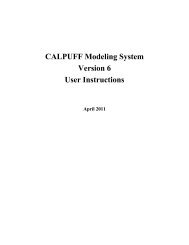Volume 1 - The Atmospheric Studies Group at TRC
Volume 1 - The Atmospheric Studies Group at TRC
Volume 1 - The Atmospheric Studies Group at TRC
You also want an ePaper? Increase the reach of your titles
YUMPU automatically turns print PDFs into web optimized ePapers that Google loves.
4. MODEL PERFORMANCE EVALUATION<br />
4.1 Evalu<strong>at</strong>ion D<strong>at</strong>asets<br />
<strong>The</strong> model performance evalu<strong>at</strong>ion performed in Task 4 assessed overall model<br />
performance, focusing on five tracer dispersion d<strong>at</strong>asets described in Task 2 th<strong>at</strong><br />
emphasize overw<strong>at</strong>er transport with shoreline impact. <strong>The</strong>se d<strong>at</strong>asets include shortrange<br />
(1 km – 8 km) overw<strong>at</strong>er dispersion experiments for on-shore flow, and longerrange<br />
(22 km – 42 km) dispersion experiments with both off-shore and on-shore flow<br />
transitions. <strong>The</strong> short-range experiments test the over-w<strong>at</strong>er boundary layer and<br />
shoreline transition components of CALMET and CALPUFF with geophysical<br />
characteristics resolved to the limit of the 200-m land use d<strong>at</strong>aset, and meteorological<br />
d<strong>at</strong>a developed for the overw<strong>at</strong>er release loc<strong>at</strong>ions. <strong>The</strong> longer-range experiments<br />
test both over-land and over-w<strong>at</strong>er components with land-w<strong>at</strong>er and w<strong>at</strong>er-land<br />
transitions, resolve geophysical fe<strong>at</strong>ures with a resolution of 1 km, and incorpor<strong>at</strong>e<br />
meteorological d<strong>at</strong>a obtained <strong>at</strong> loc<strong>at</strong>ions across the study area. None of these<br />
d<strong>at</strong>asets address model performance for transport distances on the order of 100 km to<br />
300 km. Simul<strong>at</strong>ions on this scale will be made for OCS areas using the full<br />
modeling system th<strong>at</strong> couples the output from a mesoscale meteorological model<br />
with the CALMET/CALPUFF system. Such simul<strong>at</strong>ions will depend on the<br />
transport and dispersion components of CALMET/CALPUFF evalu<strong>at</strong>ed here as well<br />
as the circul<strong>at</strong>ion fe<strong>at</strong>ures captured by the mesoscale model.<br />
<strong>The</strong> sensitivity of simul<strong>at</strong>ions to the new fe<strong>at</strong>ures developed for the system is also<br />
assessed in the evalu<strong>at</strong>ion. Altern<strong>at</strong>ive CALMET simul<strong>at</strong>ions are made with each of<br />
the COARE and mixing height options. Altern<strong>at</strong>ive CALPUFF simul<strong>at</strong>ions are made<br />
with each turbulence profiling option, and with l<strong>at</strong>eral Lagrangian timescale options<br />
0 and 1. Note th<strong>at</strong> not all options are tested for each evalu<strong>at</strong>ion d<strong>at</strong>aset. In addition,<br />
CALPUFF simul<strong>at</strong>ions are made with two choices for the minimum l<strong>at</strong>eral<br />
turbulence velocity: 0.37m/s and 0.5m/s. This is a user-configured property. <strong>The</strong><br />
CALPUFF default setting is 0.5m/s, but the OCD evalu<strong>at</strong>ions had indic<strong>at</strong>ed th<strong>at</strong><br />
0.37m/s provided better results for overw<strong>at</strong>er dispersion experiments. Because<br />
CALPUFF performance for the overw<strong>at</strong>er evalu<strong>at</strong>ion d<strong>at</strong>asets improves when the<br />
minimum l<strong>at</strong>eral turbulence velocity is 0.37m/s, a new overw<strong>at</strong>er set of minimums<br />
has been added to the model, and the default for these is set to 0.37m/s.<br />
Cameron, Louisiana<br />
Description<br />
<strong>The</strong> over w<strong>at</strong>er dispersion study in the Cameron, Louisiana area was conducted along<br />
the coast of the Gulf of Mexico during four test days in July 1981 and five test days<br />
in December 1982 (Dabberdt et al., 1982). <strong>The</strong> area is very fl<strong>at</strong> and typically wet,<br />
with numerous swamps, lakes, fens, and bayous extending inland from the coast.<br />
Final Report Vol.1 25







